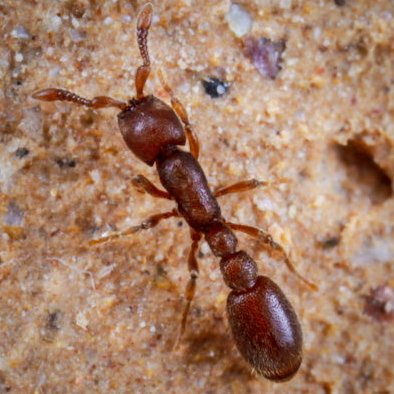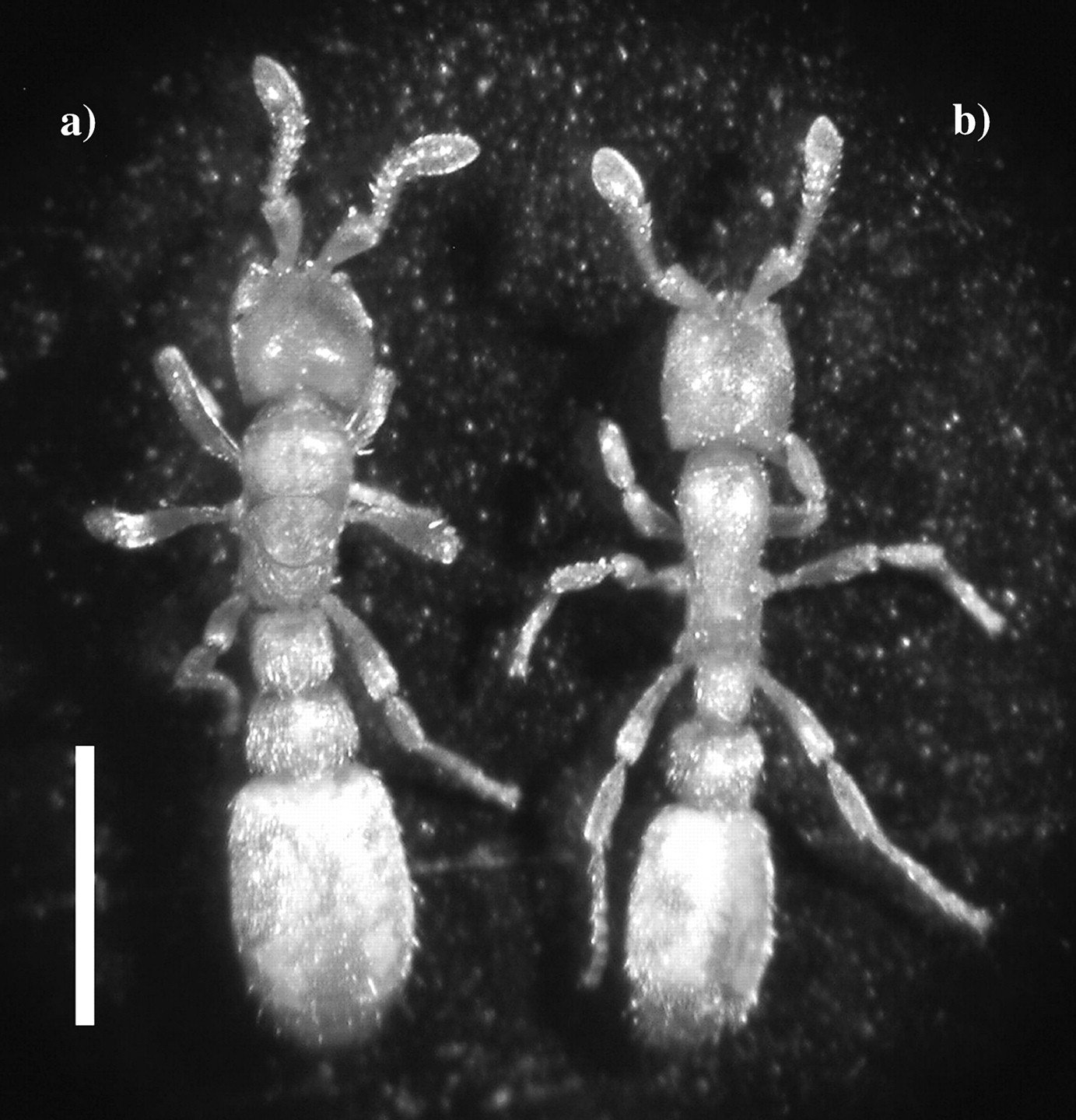Ooceraea biroi - Clonal Raider Ants - Care Guide and Ecology
Ooceraea biroi worker
Distribution & Tramp species
They can be found in their native habitats of Asia, in countries such as India, Sri Lanka, Nepal, Philippines, Malaysia, Singapore, Vietnam and China.
Worldwide distribution Antmaps.org
Since the beginning of the 19th century, this species has become established on tropical and subtropical islands around the world such as Madagascar, the Caribbean, Taiwan and some Indonesian and Japanese islands as well.
Among animals, ants are among the most destructive invasive species globally, displacing native ants and profoundly affecting other organisms and thereby disrupting local ecosystems.
But at the same time, many introduced ant species have no obvious negative ecological effects, such seems to be the case with this species.
O. biroi is considered to be a pantropical tramp ant species, and certainly one of the most inconspicuous and seldom collected.
Given the absence of winged queens and the strictly subterranean lifestyle, dispersal is almost certainly human mediated and might occur when transported soil contains colony fragments.
Common Name
Ooceraea Biroi previously known as Cerapachys Biroi, from the Greek keras [κέρας], meaning horn and pachys [παχυς] meaning thick, the "thick-horn" ant.
Ooceraea biroi worker
Referring to the thick antennae of ants in this genus, possibly an adaptation against being severed when attacked by other ants. Biroi comes from Lajos Biró, the Hungarian naturalist who collected the type specimens.
Their common name is the clonal raider ants.
Clonal, because this is one of the few ant species capable of reproducing by parthenogenesis, which means that the ants reproduce asexually… they can clone themselves!
Sub-Family/Genus
And raider because this species belongs to the Dorylinae sub-family, the Famous Army Ants!
Ooceraea biroi colony bivouac
Note: A bivouac shelter is any of a variety of improvised camp site, or shelter that is usually of a temporary nature
The ant subfamily Dorylinae contains the true army ant as well as non-army ants genera.
The true army ants, consist of eight genera in the subfamily Dorylinae, such as Aenictus, Dorylus and Eciton, etc, and are known to exhibit several specific biological characteristics such as large colony size, group predation with several workers, nomadism, and permanently wingless queens (also called ergatoid queens), which together form the army ant adaptive syndrome.
The army ant syndrome has allowed these species to become the dominant social hunters of the tropics, yet we know little about how or why these strategies evolved.
And since some of the non-army ant genera are closely related to the true army ants, they are considered to be an important key in understanding the evolution of the army ant adaptive syndrome.
Ooceraea is one of the genera considered to be closely related to the Old-World army ants but is still a non-army ant.
Clonal raider ant trail
The clonal raider ants have been the subject of many detailed studies for this reason and some others which we will discuss further ahead.
Morphology
They are very small, about 2 to 3 mm long, but stocky, heavily armored, with short and thick antennae.
Clonal raider ant worker
O. biroi has small colonies, typically consisting of a few hundred workers.
In laboratory conditions, viable colonies consist of 20 to 30 workers for the smaller sizes and from 250 to 750 workers for the larger colonies.
Recruitment & Foraging
Their foraging behavior is called group recruitment raiding and is considered as an early stage towards the evolution of the legionary syndrome. It is developed to allow specialized feeding on other social insects.
Group raids are initiated by successful scouts, who lead a raiding party to the discovered prey.
The clonal raider ants are entirely subterranean and workers are heavily armored which protect them against attack or injury when raiding the other ants.
Food preferences
O. biroi is a specialized ant predator (also known as Myrmecophagous) and feeds primarily on the brood of other ants, but also may consume the soft-bodied larvae and other smaller insects.
In the laboratory conditions, successful colonies of clonal raider ants have been offered the following different types of ant species pupae:
- Solenopsis invicta
- Tetramorium bicarinatum
- Oecophylla smaragdina
- Aphaenogaster senilis
- Pheidole sp.
Regarding insects, they will accept crushed pin-head crickets, baby roaches and fruit flies.
A quick note: ant species larvae are not normally taken.
Nesting preferences
Ooceraea biroi nest setup
They are a cryptic species in which nests occur under leaf litter, soil, and rotten wood. Natively, their nests can be found in evergreen tropical forests and secondary forests but outside of its native range, they can be found in disturbed habitats such as parks and agricultural areas.
Laboratory research nest setup
In laboratory conditions, they are normally housed in clear Petri dishes (50 to 80mm diameter × 10 to 20mm high) with circular chambers dug in a moist plaster of Paris floor. The colonies are normally kept at 25 to 27 °C and 60 to 70% humidity, either under constant light or in 12hour light/dark cycles.
Laboratory dyi nest setup
I personally chose something different, with a more natural feel and look, but with the similar dimensions.
Reproduction cycle
As we said in the beginning of the video, O.biroi are related to army ants, and the army ant syndrome is also reflected on their reproductive cycles. They have two phases of activity, a nomadic phase and a stationary phase.
Ooceraea biroi phases of activity
This biphasic reproductive cycle is mainly regulated by the maturing process of the brood.
The periodicity of their cycle appeared to depend upon stimulation arising from the brood itself rather than on an internal clock of the workers.
The nomadic phase, which lasts 16 days, is characterized by the presence of only larvae and workers.
Clonal raider ants larvae and workers
Task division is done by polyethism, which means by worker age. Older workers, the foragers, explore their surroundings looking for food and ant nests to raid, while back in the nest all the larvae develop at the same rhythm, tended by the younger workers.
The stationary (or statary) phase, which lasts 18 days, is characterized by the pupating of all the larvae, and new eggs being layed only by the younger workers through parthenogenesis. During this phase the whole colony remains in the nest.
As soon as callow workers emerge, which gives rise to an additional cohort of adult ants, the cycle re-starts with the nomadic phase, followed by the new eggs hatching into larvae again.
These cycles are kept in place by another distinctive trait, the reproductive synchrony ant enforcers, or worker policing.
Ants which for whatever reason fail to follow the cycle are brutally killed.
Castes
This species has 3 different castes.
Ooceraea biroi queen and worker
The male caste, which consists of diploid males which are exceedingly rare in this species, with only about 1 out of 10,000 diploid individuals being male.
Ooceraea biroi male
The queen caste, which consists of ergatoid queens, which are also poorly represented with less than 6% per colony in field colonies and are only involved in reproduction and brood care.
And the worker caste which can be separated into 2 behavioral subcastes according to age and thus to reproductive capacities:
Old workers which are specialized in foraging and rarely care for larvae, and young workers which remain inside the nest and perform most of the egg laying as well as most of the nursing activities, as we said before.
Clonal raider ants coloration throughout their live cycle
Reproductive strategy
Ooceraea biroi belongs to a very small number of ant species known to reproduce through thelytokous parthenogenesis.
All ants, ergatoid queens and workers, are capable of reproducing, and the egg laying task is distributed among all nest mates but in different ratios depending on being queen or worker, rendering the colonies of C. biroi virtually everlasting.
Clonal raider ant nest
Which brings us to their propagation mode, the last army ant trait, the colony fission. Given a certain size of individuals, the colony will fission into smaller groups that leave in search of new nesting grounds.
As a consequence, any colony fragment, when transferred to a new habitat, can potentially act as a founding colony for a new population. This mode of reproduction has therefore most likely contributed to the emergence of O. biroi as the only introduced dorylomorph ant.
O biroi is considered invasive, but it does not form supercolonies, which is very interesting, especially when we compare the traits between them and other invasive ant species that we have talked about before.
Budding or fission, polygyny, polydomy and unicoloniality are all traits of ant species that form super colonies.
Colony
And the main reason for not being able to form them, can be found in a recent study that has shown that individuals are able to discriminate between nestmates and non-nestmates, especially when they are of different clonal origin, thus not being unicolonial. Which is very strange for a species with such a small genetic variation.
Most researched ant in laboratory
Given all the above traits similarities and their size, Ooceraea biroi is perhaps the best studied Dorylinae species. The army ants Eciton and Dorylus have been extensively researched in the field, but their huge colonies are exceptionally difficult to manipulate in laboratory conditions. In contrast, Ooceraea biroi is a species much more easy to experiment with and has been the focal organism for multiple published laboratory-based studies. In addition to offering a rare opportunity for studying the habits of a non-army ant doryline, O. biroi has also provided some important insights into social insect biology in general.
Laboratory research gif
Ant keeping questions
So for the final part of this post I would like to talk about the most common asked questions, besides those parts that we have already discussed.
When can I split the colony into smaller colonies?
You can split them manually once they reach an adequate size.
Recommend a colony bigger than 100 workers, just make sure that you will provide an adequate number of larvae (50% of worker number).
Only do it while they are in the final stages of larval state, otherwise, there is a chance of cannibalism.
Can you mix two colonies?
You can, but you need to try it out first. As we discussed earlier, its reported that they are capable of discriminating between nestmates and non-nestmates, so drop only one worker first and observe the reaction from the colony.
Where is your colony now?
My colony failed when I went on holidays. In one of my holidays which were longer (4 weeks) and unfortunately my colony did not survive during this period even under the supervision of my helper.
Why did it fail?
Mold.
In keeping this species is important to keep high levels of humidity, but as important is ventilation.
Since they are very reactive to changes in air circulation, I kept my colony covered with a lid, and that may have been the main issue.
Because any unattended prey item, needs to be removed after 48 hours if left unattended, otherwise it will mold very fast.
And during my absence I think i forgot to explain this to my helper.
Conclusion
Well this is it for this blog post! I hope you have enjoyed it!
Let me know if you have any more questions, I will gladly answer them all!
Stay safe! See you next time!
Bye!
As always, I have left you two videos in the links down below with, in case you are interested, about the awesome characteristics of these ants.
Clonal Raider Ants | Ooceraea biroi
First steps after capture
















